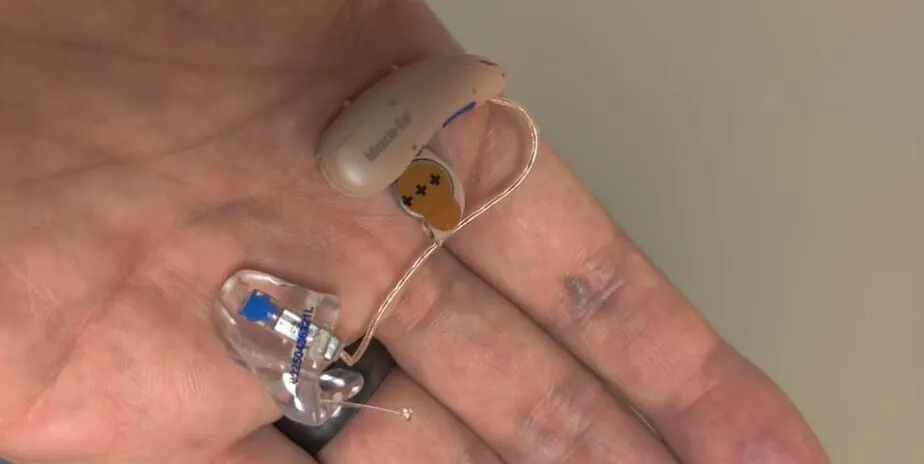Updated for 2025: Hearing aid domes are small, medical-grade silicone tips that attach to the end of receiver-in-canal (RIC) or receiver-in-the-ear (RITE) hearing aids. They sit inside the ear canal and help deliver amplified sound directly to your eardrum. Domes come in different shapes, sizes, and venting styles—each designed for specific types of hearing loss and listening needs.
As an audiologist, I often see patients get confused about which dome is best. The choice affects comfort, sound quality, feedback (whistling), and even speech clarity. This guide compares all dome types, explains when to use them, and covers when you might want to upgrade to a custom earmold instead.
Hearing Aid Dome Types & Comparison
| Type | Best For | Advantages | Disadvantages |
|---|---|---|---|
| Open Dome | Mild to moderate high-frequency hearing loss | Lets natural sound pass through; keeps your own voice sounding natural; comfortable for most | Not good for low-frequency loss; may cause feedback in moderate losses |
| Closed Dome (Vented) | Moderate hearing loss | Better bass and low-frequency amplification; improved streaming sound | Can cause occlusion effect if you hear low frequencies well |
| Power Dome (Double Dome) | Severe hearing loss | Maximum amplification; limits sound leakage | Less comfortable; may still not seal as well as custom molds |
| Custom Earmold | Mild to profound hearing loss | Perfect fit; no feedback; customizable venting; best for dexterity issues | More expensive; requires ear impressions |
Open Dome
Open domes have large vents that allow outside sound to naturally enter your ear while amplifying only the frequencies you struggle with. This makes speech sound more natural and reduces the “plugged ear” sensation. Ideal for high-frequency losses, they are not recommended for low-frequency losses or if you experience feedback issues.
Closed Dome
Closed (or vented) domes have smaller vents, blocking more outside sound and keeping amplified sound in the ear canal. This is helpful for boosting lower-pitch sounds and improving music and streaming quality. However, if you hear low frequencies well without amplification, you might experience the occlusion effect—where your own voice sounds “boomy” or echoey.
Pro Tip: If you stream music or TV frequently, a closed dome can make the bass sound richer and fuller.
Power Dome
Power domes (also called double domes) use two flanges for a tight seal. They trap sound in the ear for maximum amplification, which is important for those with severe hearing loss. However, if you need this much gain, I often recommend moving to a custom earmold for better comfort and feedback control.
Custom Earmolds

Custom earmolds are made specifically for your ear shape. They offer:
- Custom venting to balance natural sound and amplification
- Better music streaming and low-frequency response
- Locks (canal, helix, or skeleton) to keep the aid secure
- Best comfort for long wear
How Custom Earmolds Are Made
- Preparation: Ear canal inspection and cleaning
- Otoblock placement: Foam or cotton barrier to protect the eardrum
- Impression material: Soft silicone fills the canal and outer ear, hardens in 4–5 minutes
- Mold removal: Impression is taken out and checked
- Manufacturing: Impression sent to the earmold lab
- Fitting: Audiologist adjusts for comfort and seal
This process is painless and typically takes less than 15 minutes per ear.
Choosing Between Domes and Earmolds
Your audiogram is the main guide for ear coupling choice. For example:
- Mild high-frequency loss: Open dome
- Moderate loss: Closed dome
- Severe loss: Power dome or earmold
- Dexterity concerns: Custom earmold for easier handling
For over-the-counter hearing aids, start with open domes unless you stream often—then consider a closed dome.
Maintenance & Care
- Replace domes every 1–3 months
- Clean daily with a soft cloth or wipe
- Check for tears or hardening
- Keep ears free from impacted earwax
Final Audiologist Advice
Comfort and sound quality both matter. The right dome or earmold can mean the difference between wearing your hearing aids all day—or leaving them in the drawer. Work with your audiologist to find your ideal fit.

